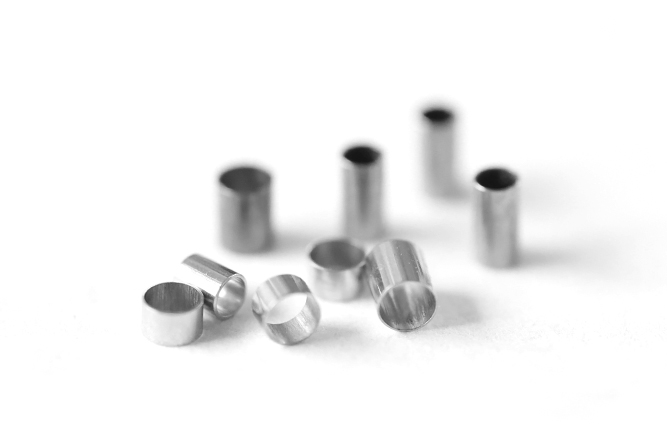Introduction
Tantalum marker bands are small, highly dense rings or bands made from tantalum, a rare, corrosion-resistant metal known for its radiopacity and biocompatibility. Tantalum’s unique properties make it an ideal choice for marker bands, allowing medical professionals to achieve greater accuracy and control. This article explores the common uses of tantalum marker bands, focusing on the medical field and industrial sectors.

Why Tantalum? Key Properties
Tantalum is chosen for marker bands due to several critical characteristics:
- Radiopacity: Ta is highly radiopaque, meaning it is visible under X-rays and fluoroscopy. This visibility allows for accurate tracking of medical devices inside the body during procedures.
- Biocompatibility: Ta is biocompatible, meaning it does not react adversely with body tissues, making it safe for use in implants and other devices.
- Corrosion Resistance: Tantalum’s resistance to corrosion ensures that it maintains its integrity over time, even within the human body.
Medical Applications of Tantalum Marker Bands
The primary use is in medical applications, where they provide essential guidance and control in various interventional procedures.
1. Guiding Catheters in Cardiology
In cardiology, tantalum marker bands are widely used on catheters to guide procedures such as angioplasty and cardiac ablation. When treating coronary artery disease, doctors use such catheters to navigate through the blood vessels toward the heart. The marker bands help ensure the catheter reaches the correct location, allowing the physician to position it precisely to open a blocked artery or deliver other treatments.
The radiopaque nature of tantalum marker bands provides clear visibility under fluoroscopy, which allows for real-time tracking. This level of precision reduces the risk of complications and helps achieve better patient outcomes.
Further reading: The Versatility of Tantalum Marker Bands: Applications and Benefits
2. Stent Placement in Vascular Procedures
Tantalum marker bands are commonly used in stents, small expandable devices inserted into blood vessels to keep them open. These medical devices allow surgeons to monitor the stent’s position and ensure it is placed accurately within the vessel. By providing visibility under imaging, they help prevent misplacement and allow for proper expansion of the stent to optimize blood flow.
This application is critical for treating atherosclerosis and other vascular diseases, where proper stent placement can make the difference between a successful procedure and complications. Tantalum marker bands thus enhance the safety and effectiveness of stent placement in both peripheral and coronary arteries.
Further reading: Application of Tantalum Marker Band in Medical Devices
3. Guiding Catheters in Neurology
In neurology, tantalum marker bands aid in guiding catheters during procedures like endovascular coiling and embolization, used to treat aneurysms and vascular malformations. These procedures require extreme precision, as even slight misplacements can lead to severe outcomes. Ta marker bands provide the radiographic visibility needed for neurosurgeons to safely navigate complex vascular structures within the brain.
Because these procedures are often delicate, using biocompatible and radiopaque materials like tantalum is essential. Tantalum marker bands help ensure that the catheter reaches and treats the target area without damaging surrounding tissues.
4. Placement of Endoscopic Devices
Endoscopic procedures often involve the placement of devices within the gastrointestinal tract. Tantalum marker bands are used in various endoscopic instruments to aid in positioning within the body. For example, marker bands are used in feeding tubes, drainage tubes, and stents placed in the gastrointestinal tract. By providing visibility, tantalum marker bands help ensure these devices are correctly positioned, improving patient safety and procedure outcomes.
Industrial Applications of Tantalum Marker Bands
While medical uses are the most common, they also find applications in industrial sectors, particularly in fields where precise positioning is essential.
1. Oil and Gas Exploration
In the oil and gas industry, marker bands are used to guide and position equipment within pipelines and boreholes. Tantalum’s resistance to corrosion and extreme temperatures makes it suitable for harsh environments encountered in oil and gas exploration. The visibility provided by marker bands helps engineers monitor equipment placement accurately, reducing risks associated with drilling operations.
2. Aerospace and Engineering
Tantalum marker bands are sometimes used in aerospace engineering for equipment that requires tracking and positioning under extreme conditions. Tantalum’s durability and resistance to corrosion make it suitable for these environments, while its radiopacity allows engineers to monitor parts remotely using X-ray or other imaging technology.
Advantages of Tantalum Marker Bands
The use of tantalum in marker bands offers significant advantages:
- Enhanced Visibility: Tantalum marker bands provide clear imaging visibility, which is critical for precise positioning and tracking.
- Reduced Risk: In medical applications, the ability to track devices accurately reduces the risk of misplacement and improves patient safety.
- Long-Term Reliability: Tantalum’s corrosion resistance ensures marker bands remain stable, even within challenging environments like the human body or industrial pipelines.
Conclusion
Tantalum marker bands have become an indispensable component in medical procedures and industrial sectors. From guiding catheters in cardiology and neurology to ensuring accurate stent placement, they offer unmatched visibility, reliability, and biocompatibility. Additionally, these marker bands have valuable applications in industries like oil and gas exploration and aerospace, where their durability and radiopacity contribute to safe and efficient operations. For more tantalum products, please check Advanced Refractory Metals (ARM).
